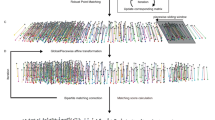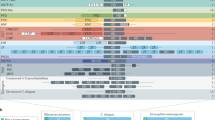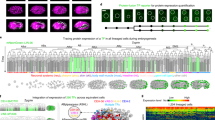Abstract
In Caenorhabditis elegans, the early embryo contains five somatic founder cells (known as AB, MS, E, C and D) which give rise to very different lineages. Two simply produce twenty intestinal (E) or muscle (D) cells each, whereas the remainder produce a total of 518 cells which collectively contribute in a complex pattern to a variety of tissues1. A central problem in embryonic development is to understand how the developmental potential of blastomeres is restricted to permit the terminal expression of such complex differentiation patterns. Here we identify a gene, lit-1, that appears to play a central role in controlling the asymmetry of cell division during embryogenesis in C. elegans. Mutants in lit-1 suggest that its product controls up to six consecutive binary switches which cause one of the two equivalent cells produced at each cleavage to assume a posterior fate. Most blastomere identities in C. elegans may therefore stem from a process of stepwise binary diversification.
This is a preview of subscription content, access via your institution
Access options
Subscribe to this journal
Receive 51 print issues and online access
$199.00 per year
only $3.90 per issue
Buy this article
- Purchase on Springer Link
- Instant access to full article PDF
Prices may be subject to local taxes which are calculated during checkout




Similar content being viewed by others
References
Sulston, J. E., Schierenberg, E., White, J. G. & Thomson, J. N. The embryonic cell lineage of the nematode Caenorhabditis elegans. Dev. Biol. 100, 64–119 (1983).
Schnabel, R., Hutter, H., Moerman, D. G. & Schnabel, H. Assessing normal embryogenesis in C. elegans using a 4D-microscope: variability of development and regional specification. Dev. Biol. 184, 234–265 (1997).
Riddle, D. L., Blumenthal, T., Meyer, B. J. & Priess, J. R. Monograph 33(Cold Spring Harbor Laboratory, New York, (1997)).
Schierenberg, E. Reversal of cellular polarity and early cell–cell interactions in the embryo of Caenorhabditis elegans. Dev. Biol. 122, 452–463 (1987).
Goldstein, B. Cell contacts orient some cell division axes in the Caenorhabditis elegans embryo. J. Cell. Biol. 129, 1071–1080 (1995).
Draper, B. W., Mello, C. C., Bowerman, B., Hardin, J. & Priess, J. R. MEX-3 is a KH domain protein that regulates blastomere identity in the early C. elegans embryo. Cell 87, 205–216 (1996).
Hunter, C. P. & Kenyon, C. Spatial and temporal controls target pal-1 blastomere-specification activity to a single blastomere lineage in C. elegans embryos. Cell 87, 217–226 (1996).
Drubin, D. G. & Nelson, W. J. Origins of cell polarity. Cell 84, 335–344 (1996).
Lin, R., Thompson, S. & Priess, J. R. Pop-1 encodes an HMG box protein required for the specification of a mesoderm precursor in early C. elegans embryos. Cell 83, 599–609 (1995).
Guo, S. & Kemphues, K. J. Molecular genetics of asymmetric cleavage in the early Caenorhabditis elegans embryo. Curr. Opin. Genet. Dev. 6, 408–415 (1996).
Weintraub, H. et al. The myoD gene family: nodal point during the specification of the muscle cell lineage. Science 255, 761–766 (1991).
Schnabel, R. Pattern formation: regional specification in the C. elegans embryo. BioEssays 18, 591–594 (1996).
Rivera-Pomar, R. & Jäckle, H. From gradients to stripes in Drosophila embryogenesis: filling in the gaps. Trends Genet. 12, 478–483 (1997).
St Johnston, D. & Nüsslein Volhard, D. The origin of pattern and polarity in the Drosophila embryo. Cell 68, 201–220 (1992).
Lin, H. & Schagat, T. Neuroblasts: a model for the asymmetric division of stem cells. Trends Genet. 13, 33–39 (1997).
Greenwald, I. S., Sternberg, P. W. & Horvitz, H. R. The lin-12 locus specifies cell fates in C. elegans. Cell 34, 435–444 (1983).
Hodgkin, J. & Doniach, T. Natural variation and copulatory plug formation in C. elegans. Genetics 146, 149–164 (1997).
Wood, W. B. The nematode Caenorhabditis elegans(Cold Spring Harbor Laboratory, New York, (1988)).
Hutter, H. & Schnabel, R. glp-1 and inductions establishing embryonic axes in Caenorhabditis elegans. Development 120, 2051–2064 (1994).
Priess, J. R. & Thomson, J. N. Cellular interactions in early C. elegans embryos. Cell 48, 241–250 (1987).
Schnabel, R. & Schnabel, H. Early determination in the C. elegans embryo: a gene, cib-1, required to specify a set of stem-cell-like blastomers. Development 108, 107–119 (1990).
Priess, J. R., Schnabel, H. & Schnabel, R. The glp-1 locus and cellular interactions in early C. elegans embryos. Cell 51, 601–611 (1987).
Kemphues, K. J., Priess, J. R., Morton, D. G. & Cheng, N. Identification of genes required for cytoplasmic localization in early C. elegans embryos. Cell 52, 311–320 (1988).
Hutter, H. & Schnabel, R. Specification of anterior–posterior differences within the AB lineage in the C. elegans embryo: a polarising induction. Development 121, 1559–1568 (1995).
Author information
Authors and Affiliations
Rights and permissions
About this article
Cite this article
Kaletta, T., Schnabel, H. & Schnabel, R. Binary specification of the embryonic lineage in Caenorhabditis elegans. Nature 390, 294–298 (1997). https://doi.org/10.1038/36869
Received:
Accepted:
Issue Date:
DOI: https://doi.org/10.1038/36869
This article is cited by
-
Structure, phylogeny, and expression of the frizzled-related gene family in the lophotrochozoan annelid Platynereis dumerilii
EvoDevo (2015)
-
Expression of Nemo-like kinase after spinal cord injury in rats
Journal of Molecular Neuroscience (2014)
-
Actomyosin-based Self-organization of cell internalization during C. elegans gastrulation
BMC Biology (2012)
-
Mass spectrometric comparison of N-glycan profiles from Caenorhabditis elegans mutant embryos
Glycoconjugate Journal (2012)
-
Wnt signaling through T-cell factor phosphorylation
Cell Research (2011)
Comments
By submitting a comment you agree to abide by our Terms and Community Guidelines. If you find something abusive or that does not comply with our terms or guidelines please flag it as inappropriate.



